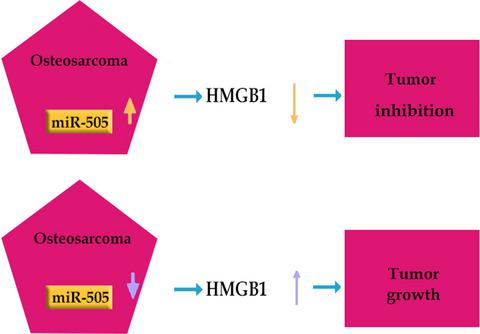当前位置:
X-MOL 学术
›
FEBS Open Bio
›
论文详情
Our official English website, www.x-mol.net, welcomes your
feedback! (Note: you will need to create a separate account there.)
miR-505 inhibits proliferation of osteosarcoma via HMGB1.
FEBS Open Bio ( IF 2.8 ) Pub Date : 2020-05-31 , DOI: 10.1002/2211-5463.12868 Guangzhang Li 1 , Fajing Liu 2 , Jun Miao 2 , Yongcheng Hu 3
FEBS Open Bio ( IF 2.8 ) Pub Date : 2020-05-31 , DOI: 10.1002/2211-5463.12868 Guangzhang Li 1 , Fajing Liu 2 , Jun Miao 2 , Yongcheng Hu 3
Affiliation

|
Osteosarcoma is a malignant bone tumor, and clinically detectable metastases can be detected in ~ 15–20% of patients when they seek medical advice; patients with metastatic disease have extremely poor prognosis. Here, we examined the involvement of the microRNA miR‐505 in osteosarcoma. Eighty‐four patients seeking treatment for osteosarcoma were included in the study group (SG), and 63 healthy subjects were allocated to the control group (CG). Normal human bone cells MG‐63 and U20S cells were transfected with miR‐505 mimics, miR‐NC, HMGB1 RNA for targeted inhibition (si‐HMGB1), and si‐NC to examine the effects on HMGB1 expression. Cell proliferation, invasion, and apoptosis were measured using CCK‐8, scratch assays, and flow cytometry (FCM), respectively, and the relationship between miR‐505 and HMGB1 was determined using the dual‐luciferase reporter assay. In patient tissues and serum, miR‐505 was expressed at a low level, and HMGB1 was expressed at a high level, with an area under curve of > 0.9. Furthermore, the expression of miR‐505 and HMGB1 in tissues had a positive association with that in the serum, whereas the expression of miR‐505 had a negative association with that of HMGB1 in tissues only. Overexpression of miR‐505 and silencing of HMGB1 suppressed the proliferation, migration, and invasion of osteosarcoma cells and increased the rate of apoptosis, whereas the co‐transfected miR‐505 mimics + si‐HMGB1 demonstrated a more significant inhibitory effect on the proliferation and invasion of osteosarcoma cells and a higher apoptosis rate. miR‐505 may inhibit the proliferation and invasion and promote apoptosis of osteosarcoma cells by targeting and suppressing HMGB1.
中文翻译:

miR-505 通过 HMGB1 抑制骨肉瘤的增殖。
骨肉瘤是一种恶性骨肿瘤,约 15-20% 的患者在就医时可检测到临床可检测的转移;转移性疾病患者预后极差。在这里,我们检查了 microRNA miR-505 在骨肉瘤中的参与。84 名寻求骨肉瘤治疗的患者被纳入研究组(SG),63 名健康受试者被分配到对照组(CG)。用 miR-505 模拟物、miR-NC、HMGB1 RNA 进行靶向抑制 (si-HMGB1) 和 si-NC 转染正常人骨细胞 MG-63 和 U20S 细胞以检查对 HMGB1 表达的影响。分别使用 CCK-8、划痕分析和流式细胞术 (FCM) 测量细胞增殖、侵袭和凋亡,使用双荧光素酶报告基因测定确定 miR-505 和 HMGB1 之间的关系。在患者组织和血清中,miR-505低表达,HMGB1高表达,曲线下面积>0.9。此外,组织中miR-505和HMGB1的表达与血清中的表达呈正相关,而miR-505的表达仅与组织中的HMGB1的表达呈负相关。miR-505的过表达和HMGB1的沉默抑制了骨肉瘤细胞的增殖、迁移和侵袭并增加了细胞凋亡率,而共转染的miR-505模拟物+si-HMGB1表现出更显着的增殖和抑制作用。骨肉瘤细胞的侵袭和较高的凋亡率。
更新日期:2020-05-31
中文翻译:

miR-505 通过 HMGB1 抑制骨肉瘤的增殖。
骨肉瘤是一种恶性骨肿瘤,约 15-20% 的患者在就医时可检测到临床可检测的转移;转移性疾病患者预后极差。在这里,我们检查了 microRNA miR-505 在骨肉瘤中的参与。84 名寻求骨肉瘤治疗的患者被纳入研究组(SG),63 名健康受试者被分配到对照组(CG)。用 miR-505 模拟物、miR-NC、HMGB1 RNA 进行靶向抑制 (si-HMGB1) 和 si-NC 转染正常人骨细胞 MG-63 和 U20S 细胞以检查对 HMGB1 表达的影响。分别使用 CCK-8、划痕分析和流式细胞术 (FCM) 测量细胞增殖、侵袭和凋亡,使用双荧光素酶报告基因测定确定 miR-505 和 HMGB1 之间的关系。在患者组织和血清中,miR-505低表达,HMGB1高表达,曲线下面积>0.9。此外,组织中miR-505和HMGB1的表达与血清中的表达呈正相关,而miR-505的表达仅与组织中的HMGB1的表达呈负相关。miR-505的过表达和HMGB1的沉默抑制了骨肉瘤细胞的增殖、迁移和侵袭并增加了细胞凋亡率,而共转染的miR-505模拟物+si-HMGB1表现出更显着的增殖和抑制作用。骨肉瘤细胞的侵袭和较高的凋亡率。











































 京公网安备 11010802027423号
京公网安备 11010802027423号